The Parachute First-Aid Packet

Members of the 325th GIR loaded into a WACO Glider in preparation for the invasion of Holland. Note the GI at the front left wears two Packets, one mounted on his M-1936 Suspenders, and another attached to his helmet net.
Background:
The Parachute First-Aid Packet (Item # 9778500) was originally designed and used by the United States Army Air Forces. It was to be issued to every parachute wearer, and contained supplies to treat wounds which may be incurred during descent or landing. The development of the Airborne in 1942 saw this kit being issued to Airborne troops too. This article will look at the two patterns of the Parachute First-Aid Packet, and also its contents and issue.
First Pattern Packet:
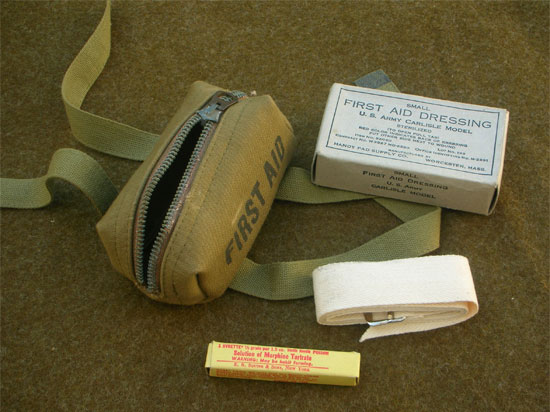
Photograph showing the First Pattern Packet, and its intended contents. The tapes used to secure the packet to equipment can be seen stitched to the bottom of the packet.
The first pattern Packet consisted of a rubberized khaki-colored canvas pouch (it feels a bit rugged), which was closed using a zipper (usually a “Crown” type), and which was attached to equipment using two long tapes stitched to the bottom of the packet. This first pattern packet was originally reserved for use by USAAF flight crews, and was designated to be worn securely on the right lift web opposite the rip cord handle.
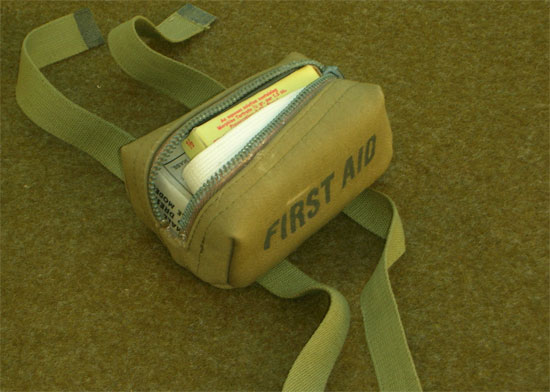
View of packed contents. The only marking, as it appears on one side of the Packet. Please note the other side is identical.
The only official markings on this first pattern packet were the words “![]() ” in large, black block capitals, using a bold sans-serif font, which were printed on both sides of the kit. Extra markings were, however, added to the packet by individuals, and examples of this first pattern Packet can be found bearing small improvised red crosses, in varying locations. AAF Manual 55-0-1 prescribes that the kit should be attached to the harness with the label exposed, for obvious reasons.
” in large, black block capitals, using a bold sans-serif font, which were printed on both sides of the kit. Extra markings were, however, added to the packet by individuals, and examples of this first pattern Packet can be found bearing small improvised red crosses, in varying locations. AAF Manual 55-0-1 prescribes that the kit should be attached to the harness with the label exposed, for obvious reasons.
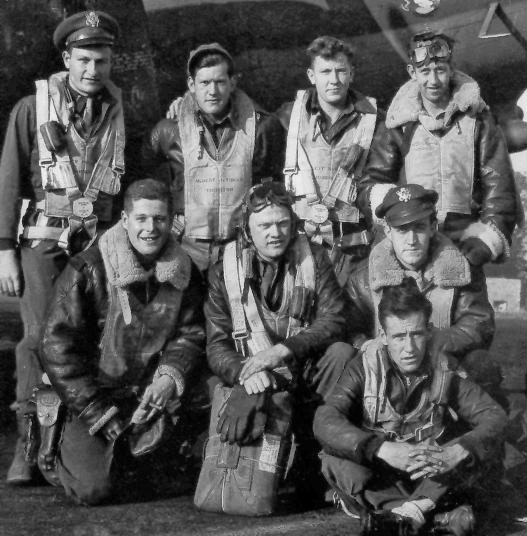
Crew of a B-17F-27-BO Bomber of the 8th US Army Air Force, illustrating wear of the first pattern Packet, First Aid, Parachute, Item No. 97785. European Theater, spring of 1944.
Second Pattern Packet:
The second pattern packet was constructed of lighter weight waterproofed canvas. Unlike its predecessor, the second pattern packet was hermetically sealed and was to be opened by tearing the material using notches located at the top and bottom end of the packet. Once again the packet was to be attached to equipment by means of two material tapes which were stitched to the packet using a zig-zag style stitching technique.
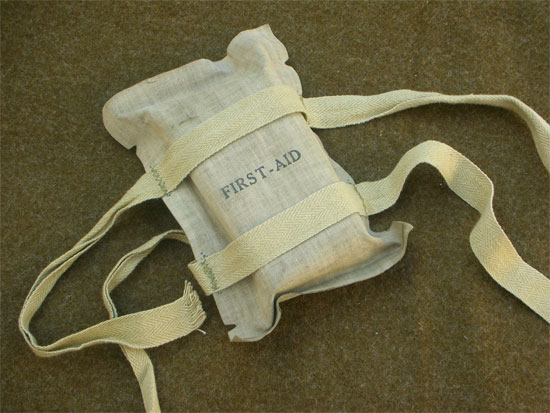
Second Pattern First-Aid Packet shown here unopened with its original contents still inside. The notched tear indicators are clearly visible.
Markings on this second pattern Packet were similar to those of the first style container, except this time a less bold, i.e. smaller serif font was used, and the two words were separated by way of a hyphen “-“. However recent evidence would also suggest that around the time of “Operation Market Garden” (September 1944), an alternative marking began to be seen, using identical text and layout, except for the font face, which was this time a sans-serif example.
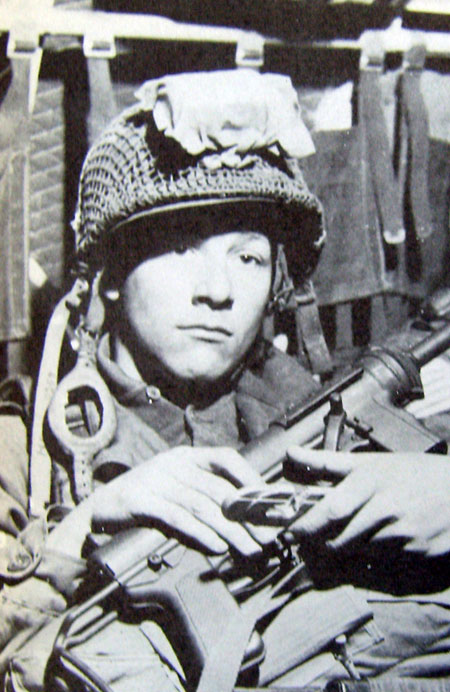
A young Paratrooper is shown here wearing the Second Pattern First-Aid Packet on his helmet. He is believed to be from the 82d Airborne Division.
The idea of this second packet was that it was expendable. The package was hermetically sealed, and could only be opened by tearing, and thus once opened could not be sealed again. AAF Manual 55-0-1 states the following, as advice for using the packet:
It can be opened by tearing either end, when needed.
Contents of the Packet:
There is a great variation in the cited contents of the Packet, First-Aid, Parachute, Complete. For example MED 6 of 1 March, 1944 lists the following contents:
- Morphine Tartrate, 1 Tube (9115700 )
- Sulfadiazine, 8 Tablets (9120400 )
- Sulfanilamide, Crystalline, 5, 5-Gm Envelopes (9121100 ) (1 Envelope)
- Dressing, First-Aid, Small, Field Brown (9206100)
- Tourniquet, Field (9378000)
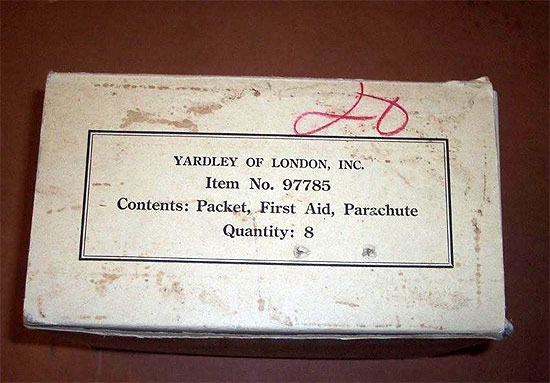
Illustration showing a large cardboard box, which originally contained 8 Parachute First-Aid Packets. The box indicates that at least one contractor of these items were Yardley of London, Inc.
From the collection of Kriss Usherwood
It should however be noted that the packet of 8 Sulfadiazine Tablets was added to the contents sometime between April 1943 and March 1944. This information is based on the list of the contents taken from FM 21-11 (First Aid for Soldiers) which lists only three components:
- 1 Tourniquet
- 1 Wound Dressing
- 1 Morphine Tartrate Syrette (1/2-grain)
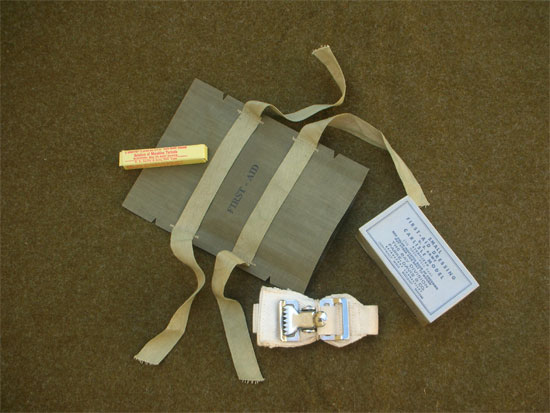
The illustration above shows the Second Pattern Packet (reproduction), with early WWII contents. Not pictured here is the Instruction Leaflet mentioned below.
The packet also included an instruction sheet giving basic procedures for the administration of the tourniquet and morphine syrette therein contained. This author has seen two different layouts and references for this instruction sheet, both having differing reference numbers. The following reference numbers are known to have appeared on the sheet:
- 16-28598-1 GPO
- 16-27688-1 GPO
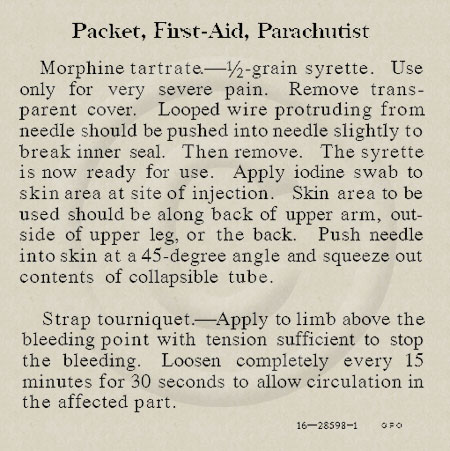
Illustration showing a recreation of the instruction document found inside the Parachute First-Aid Packet.
GPO here stands for Government Printing Office, and it is believed that these numbers are perhaps contract numbers for the printing office, while the explanation for the distinction in numbers is a result of supply by different manufacturers. This is however only an assumption.
It is interesting to note, that despite the complete contents being listed as above, already appear in 1944, the AAF Manual 55-0-1 of June, 1945 lists the following contents:
The water-proof packet contains a small first aid dressing, a morphine syrette, and a field tourniquet.
In 1945, the contents of the packet were slightly amended to follow new guidelines introduced by the Surgeon General. The white First Aid Dressing was replaced with the dyed Field Brown dressings. In addition, the sulfanilamide shaker envelope was dropped, following the discovery that crystalline sulfanilamide actually made the wound dirtier!
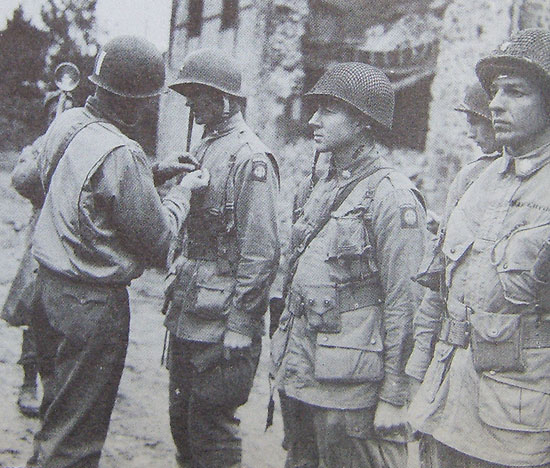
Lt. General Omar N. Bradley decorates Brig. General James M. Gavin (Asst Cdr 82d Abn Div), Lt. Colonel Edward C. Krause (CO 3d Bn, 505th PIR) and Lt. Colonel Benjamin H. Vandervoort (CO 2d Bn, 505th PIR). Note that Krause wears the First-Aid Packet on his M-1936 Suspenders.
Issue to Troops:
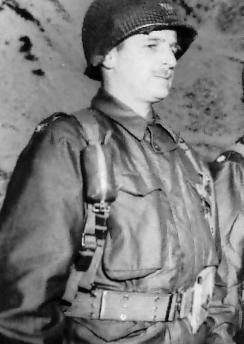
Colonel Reuben H. Tucker, CO 504th Parachute Infantry Regiment (82d Abn Div), during an awards ceremony, wears the First Pattern First-Aid Kit on his Suspenders. Belgium, January 1945.
As already mentioned, the Parachute First-Aid Packet was originally designed for every parachute wearer, however it was also issued to Airborne troops, and first wave assault troops on D-Day. These First-Aid Packets can be found worn in various locations by paratroopers: on the helmet, on the ankle, although most commonly to the suspenders or webbing.
